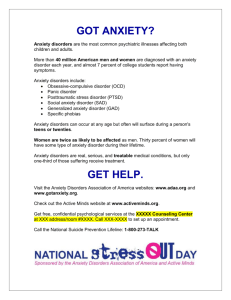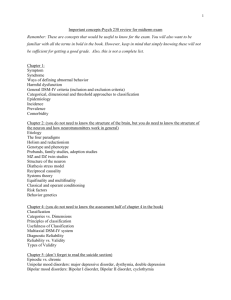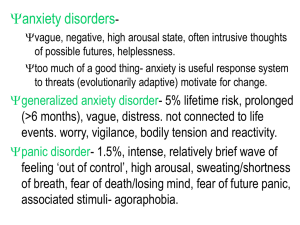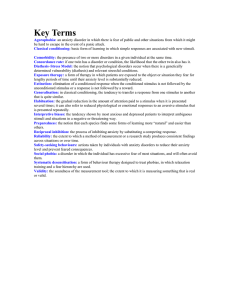Social Psychology: Personal Perspectives (Chapter 14)
advertisement
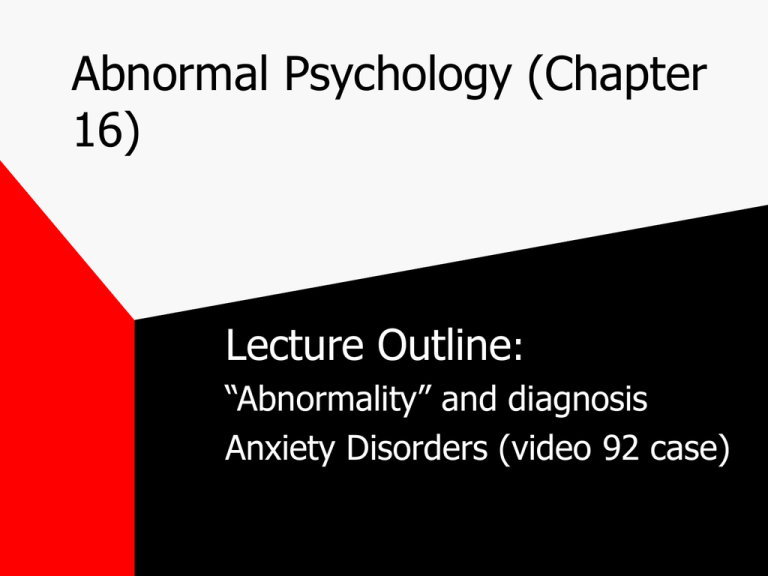
Abnormal Psychology (Chapter 16) Lecture Outline: “Abnormality” and diagnosis Anxiety Disorders (video 92 case) Quiz • • • • • 40 questions, 2 points each (80 points) Chapters 11, 13, 16 13/14 questions/chapter 3-4 short answer questions (20 points) Get to class on time please!!!!!! On the sheet of paper, list three things you are afraid of Abnormality • Behavior is – Statistically unusual – Maladaptive or harmful behavior – Labeled “abnormal” because of a violation of cultural standards – Mental disorder as suffering, personal distress • Historical examples of abnormal behavior: – psychosis: demon possession, syphillis – mentally retarded individuals & midgets were “court-jesters” – Salem witch trials: girls may have ingested ergot, LSD derivative Salem witch trial Models of abnormality • Psychodynamic: Intrapsychic conflict – e.g., sexual abuse and conversion disorder • Humanistic: Oversensitivity to others – e.g., alcoholism for social anxiety • Behavioral: Reinforcement/Punishment – e.g., snake bite leads to snake phobia • Cognitive: Distorted thinking – e.g., negative thoughts and depression • Medical: Physiological imbalance Diagnosis: DSM-IV • Diagnostic and Statistical Manual, 4th Ed. (APA, 1994) • Axis I: Clinical syndromes/ Mental disorders • Axis II: Personality and Disorders • Axis III: General Medical Conditions • Axis IV: Psychosocial and Environmental Problems • Axis V: GAF Scale (1:low to 100:high) Problems with DSM • Overdiagnosis, e.g., attention problems • Power of diagnostic labels, e.g., person “becomes the disorder” • Mental disorder vs. “everyday problems”, e.g., bad spellers? • Illusion of objectivity • But diagnosis leads to treatment, categories lead to empirical verification, and there is cross-cultural evidence of various mental health problems such as psychosis and depression Anxiety Disorders Symptoms of Anxiety • Symptoms of anxiety: – Mood: tension, apprehension and panic – Cognitive: catastrophe, concentration – Somatic: Sweat, pulse, dizzy, pounding – Motor: Tics, bite nails, pace, fidget • Case examples of clients with anxiety disorders, with emphasis on panic disorder (video #92) Case example: Social phobia "I couldn't go on dates or to parties. For a while, I couldn't even go to class. My sophomore year of college I had to come home for a semester." "My fear would happen in any social situation. I would be anxious before I even left the house, and it would escalate as I got closer to class, a party, or whatever. I would feel sick to my stomach--it almost felt like I had the flu. My heart would pound, my palms would get sweaty, and I would get this feeling of being removed from myself and from everybody else." "When I would walk into a room full of people, I'd turn red and it would feel like everybody's eyes were on me. Iwas too embarrassed to stand off in a corner by myself, but I couldn't think of anything to say to anybody. I felt so clumsy, I couldn't wait to get out." Specific kinds of anxiety disorders • Phobias: Simple, social, and agoraphobia • Panic Disorder: Bouts of intense and uncontrollable anxiety • Generalized anxiety disorder: Chronic • Stress Disorder: PTSD • Obsessive-Compulsive Disorder – obsession: unwanted impulses or thoughts – compulsion: uncontrolled repetitive act Etiology (Cause) of Anxiety • Psychodynamic: External threats – guilt after id-superego struggle • Learning theory: Classical conditioning – sexual anxiety after unprotected sex • Cognitive: Anxious cognitions – public speaking catastrophes • Humanistic-Existential: “A” gets a “B” • Physiological: Autonomic reactivity



